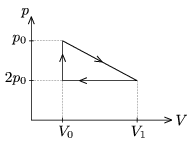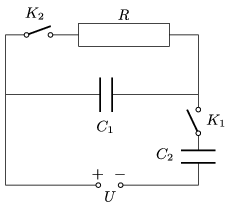KöMaL Problems in Physics, April 2009
Please read the rules of the competition.
Show/hide problems of signs:
 |
Problems with sign 'M'Deadline expired on May 11, 2009. |
M. 296. Give an estimation for the diameter of the grains of a known material, - for example playground sand - according to the rate of its settling process in a known liquid.
(6 pont)
 |
Problems with sign 'P'Deadline expired on May 11, 2009. |
P. 4154. Andrew and Ben are running uniformly along a circular track. If they run in opposite directions between two meetings Andrew steps 225 and Ben steps 220, while if they run in the same directions they have to step ten times as much. Ben is quicker then Andrew.
a) How many steps is one lap for Andrew and for Ben?
b) Determine the ratio of the speeds of the two runners.
(4 pont)
P. 4155. The electrical power of a vacuum cleaner is 1 kW. According to its description its airflow is 52 litre/s. The diameter of the tube is 3 cm. What percent of the total power is used to accelerate the air?
(4 pont)
P. 4156. Why can a water strider or a blade of a razor float on the surface of water?
(3 pont)
P. 4157. What is the least horizontal force which can turn over a cube which is on a horizontal tabletop? Examine the following three cases:
a) 
 0;
0;
b)  =0.2;
=0.2;
c)  =1.
=1.
(5 pont)
P. 4158. A uniform solid disc of radius 10 cm and of mass 5 kg is rotated at an angular speed of 120 1/s along its horizontal symmetry axis, and carefully, without giving any initial speed to it, it is placed to a horizontal surface. The coefficient of friction between the disc and the surface is 0.4.
Determine the work done by the frictional force on the disc, while it covers a distance of 5 m:
a) with using the definition of work done;
b) with using the work-energy theorem.
(Neglect air resistance and rolling friction, and calculate with g=10 m/s2.)
(5 pont)
P. 4159. Two loud speakers, in the open air, emit the same frequency of sound in phase. One of them is at the origin of the coordinate system, and the other is at the point x1=0, y1=2.4 m. An observer is standing at the point x2=40 m, y2=0, and then along a straight line parallel to the y axis he walks to the direction of positive and negative y. While he is walking he finds that the intensity of sound decreases to both directions. What can the frequency of sound be? Along the same line can he find similar points?
(4 pont)
P. 4160. A heat engine, operating with monatomic ideal gas undergoes the cyclic process shown in the figure.

Find the efficiency of the engine in the following cases:
a) ;
b) V1=2V0;
c) V1=3V0.
(5 pont)
P. 4161. The capacitors arranged as shown in the figure are all neutral. At a certain instant switch K1 is closed.

a) Find the voltage across each capacitors after switch K1 is closed.
b) After a short time switch K2 is closed as well. Determine the energy of the condensers.
c) How much heat was generated in the system after closing switch K2?
(5 pont)
P. 4162. A magnetized needle can swing horizontally inside a solenoid whose symmetry axis is horizontal. The length of the solenoid is 25 cm, and the number of its turns is 100. When there is no current in the solenoid the needle makes 10 total swings in each minute due to the magnetic field of the Earth. Now the solenoid is placed such, that its symmetry axis is perpendicular to the magnetic meridian. The needle makes 51 swings in each minute when the current in the solenoid is 1 A.
a) What is the horizontal component of the magnetic field of the Earth at the location of the experiment?
b) How many swings does the needle make if the direction of the current in the solenoid is changed? (Its magnitude remains the same.)
(4 pont)
P. 4163. Use a converging lens of diameter d and of power D dioptre and project the image of the Sun onto a white screen.
a) What is the size of the Sun on the screen?
b) By what factor will the image of the Sun on the screen be brighter than the rest of the screen which is directly shone by the Sun?
The angle subtended by the Sun is 32 arcminutes.
Data: D1=12 m-1, d1=35 mm; and , d2=60 cm.
(4 pont)
Upload your solutions above.
